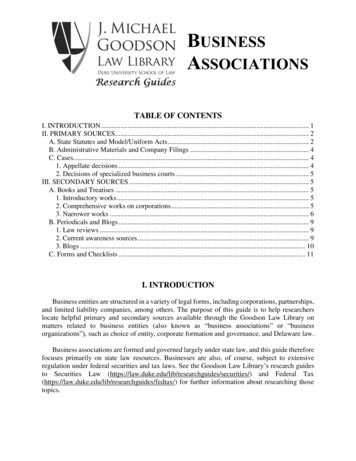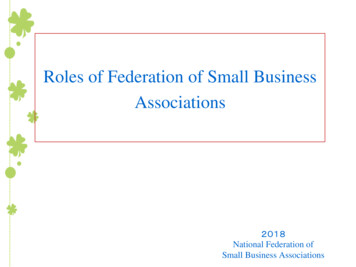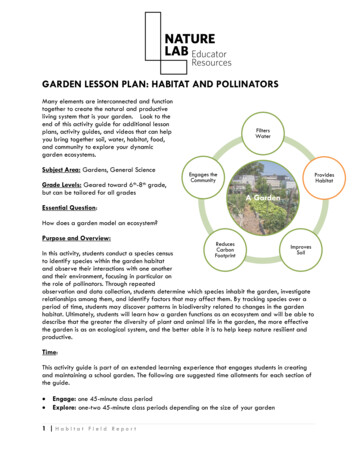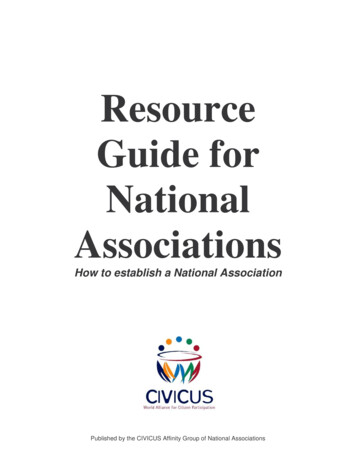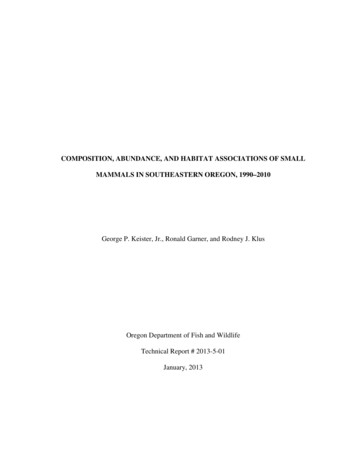
Transcription
COMPOSITION, ABUNDANCE, AND HABITAT ASSOCIATIONS OF SMALLMAMMALS IN SOUTHEASTERN OREGON, 1990–2010George P. Keister, Jr., Ronald Garner, and Rodney J. KlusOregon Department of Fish and WildlifeTechnical Report # 2013-5-01January, 2013
TABLE OF CONTENTSABSTRACT .1INTRODUCTION .2STUDY AREA .2METHODS 5Small Mammal Capture .5Data Analysis .5RESULTS .7Composition .7Abundance .8Weather .12Habitat Associations .13DISCUSSION 14Composition .14Abundance .14Habitat Associations .15CONCLUSIONS AND MANAGEMENT IMPLICATIONS .17ACKNOWLEDGEMENTS .17LITERATURE CITED .18APPENDICES .20Appendix A. Total number of individuals of each mammalian species captured inthree vegetation-types in Lake County, Oregon near Diablo Mountain during latespring 1990–1991 .21Appendix B. Total number of individuals of each mammalian species captured inthree vegetation-types in southern Harney County, Oregon during late spring 1990–1992 22Appendix C. Total numbers of each species captured at four sites in southernHarney County, Oregon during late spring, 1990–2010 23Appendix D. Small mammal abundance (captures/100 trap-nights) at four sites insouthern Harney County, Oregon during late spring, 1990–2010 .24
LIST OF TABLESTable 1. Total number of individuals of each mammalian species captured in threevegetation-types is southern Harney County, Oregon during late spring, 1994–2010. 8Table 2. Small mammal abundance (captures/100 trap-nights) in southern Harney County,Oregon during late spring, 1990–2010 .10Table 3. Correlation coefficients (r) for small mammal abundance (captures/100 trapnights) in southern Harney County, Oregon vs. fall–spring precipitation, summerprecipitation, and snowfall at Hart Mountain National Antelope Refuge during the justcompleted fall–spring and vs. the prior year, 1993–2010. .13LIST OF FIGURESFigure 1. Approximate location of each of three study areas in southeastern Oregon .3Figure 2. Approximate location of trap sites and alternate-year transects in southern HarneyCounty, Oregon 4Figure 3. Annual fluctuations in small mammal abundance in southern Harney County,Oregon during late spring, 1990–2010 .9Figure 4. Annual fluctuations in abundance of several species of small mammals insouthern Harney County, Oregon during late spring. 1990–2010 .11Figure 5. Fall–spring precipitation (September–May), summer precipitation (June–August),and snowfall (November–May) at Hart Mountain National Antelope Refuge, 1993–2010 12
ABSTRACTAs a part of a baseline study, we trapped small mammals and compared abundance andcomposition between common vegetation-types in southeastern Oregon (1990-2010). Themajority of the study was in Harney County where we trapped small mammals along transects intwo native sagebrush-steppe vegetation-types and a 1960s era crested wheatgrass (Agropyroncristatum) seeding during 1990 through 2010. We documented small mammal abundance andcomposition, examined fluctuations in abundance, and compared numbers among the threevegetation-types. Nine species were captured; deer mice (Peromyscus maniculatus) made up thehighest proportion of all captures and Merriam’s ground squirrels (Urocitellus canus) were thesecond-most numerous. Highest peaks in abundance of all species combined occurred during1994 and 2006. Both peaks were followed by a sharp decline in abundance. We found nosignificant relationship between small mammal abundance and seasonal precipitation orsnowfall, which indicated small mammals were not limited by food or winter severity during ourstudy. Differences in small mammal abundance were found among the three vegetation-types.Combined abundance of all species was greatest in the Wyoming big sagebrush (Artemisiatridentata wyomingensis) vegetation-type and least in low sagebrush (A. arbuscula). When onlythe Wyoming big sagebrush and crested wheatgrass seeding vegetation-types were compared,numbers of small mammals were similar. The relationship of relative abundance betweenspecies depended not only on habitat preferences but changed with population fluctuations;therefore, temporal patterns should be considered in designing short-term studies of smallmammals. Results from this and other studies indicate that small mammal populations in crestedwheatgrass seedings likely increase in diversity and abundance as plant diversity increases withreestablishment of native plants through time. To better understand mechanisms of populationfluctuations, future research could focus on demographic studies as well as comparative ormanipulative experiments. In addition, we made suggestions regarding use of these results tohelp evaluate future development projects in southeastern Oregon.1
INTRODUCTIONMost of southeastern Oregon is composed of shrub-steppe plant communities dominatedby sagebrush (Artemisia spp.). These sagebrush communities, located primarily in the northernGreat Basin, are contiguous with large expanses of similar plant communities in southwesternIdaho and northern Nevada. The area is generally characterized by harsh climates, with relativelyhigh elevations, low precipitation, and short growing seasons. As a result, ecosystems tend to beless complex and have lower species diversity than warmer, more mesic ecosystems. Severalspecies of small mammals are present and are likely an important food source for raptors andmammalian predators and therefore play an important role in shrub-steppe ecosystems.Studies of small mammals in and adjacent to southeastern Oregon have been few andshort-term. Feldhamer (1979a) described home ranges of three species of small mammals atMalheur National Wildlife Refuge in 1974 and 1975 as well as factors affecting abundance anddistribution of small mammals during 1973–1975 (Feldhamer 1979b). Boula and Sharp (1985)compared small mammal abundance and composition on native rangeland and a crestedwheatgrass seeding in northern Harney County, Oregon. Seasonal activity patterns were studiedin west-central Nevada (O’Farrell 1974) and a base line descriptive study was conducted innortheastern Nevada (O’Farrell and Clark 1986). Larrison and Johnson (1973) studied smallmammal density and habitat preferences in Idaho. None of these studies investigated multi-yearfluctuations in abundance of small mammals.Our primary purpose was to describe abundance and composition of small mammals overa long time period in habitats that make up a large portion of southeastern Oregon. We hoped theresults of this study would lead to a better understanding of the effects of future development andhabitat conversions on small mammals, as well as the relationship between small mammals andother species, particularly raptors and other predators. We began the study in 1990 on threestudy areas, in each of three counties (Fig. 1). However, due to logistical constraints, we onlytrapped in Malheur County in 1990 and in Lake County in 1990 and 1991. At the HarneyCounty study area, we trapped from 1990 through 2010. We did not trap in 1993. After datawere collected, we investigated possible climatic reasons for fluctuations and compareddifferences in small mammal abundance and composition between Wyoming big sagebrush(Artemisia tridentata wyomingensis), low sagebrush (A. arbuscula), and a crested wheatgrass(Agropyron cristatum) seeding.STUDY AREASIn the Malheur County study area, between Burns Junction, OR and Fields, OR (Fig. 1),DeStefano (1990) captured small mammals as part of a kit fox investigation contracted by theOregon Department of Fish and Wildlife. Small mammals were captured in three vegetationtypes: 1) vegetated sand dunes, 2) Wyoming big sagebrush, and 3) a mosaic of shrub-grassdesert pavement. In Lake County, we trapped small mammals near Diablo Mountain (Fig. 1) intwo Wyoming big sagebrush sites and one low sagebrush site. The Harney County study areawas our main focus and was located in the southwest corner of the county on land managed bythe Bureau of Land Management (BLM) (Fig. 1). It was 58 km southeast of Hart MountainNational Antelope Refuge (HMNAR) headquarters and 13 km north of the Nevada border andcentered around Acty Mountain (42º 06.1N, 119º 07.9W) (Fig. 2).2
The area was characterized by rolling topography at 1,675–1,830 m elevation, with a fewhills and ridges from 2,000–2,139 m elevation. Annual precipitation ranged from 25–31 cm,occurring primarily during winter months as snow and during spring as rain. Habitats consistedof plant communities made up primarily of a sagebrush overstory with an understory of variousnative bunchgrasses and forbs. Big sagebrush plant communities occurred in deeper, loamy soilsand low sagebrush plant communities occurred in shallow soils (Franklin and Dyrness 1973,unpublished report on file at Lakeview BLM, Lakeview, Oregon). Wyoming big sagebrushoccurred below 1,740 m and mountain big sagebrush (A. t. vaseyana) above (unpublishedreport on file at Lakeview BLM, Lakeview, Oregon).Figure 1.Approximate location of each of three study areas in southeastern Oregon.(Map created with TOPO! and used with permission (c) 2004 National Geographic)3
Figure 2. Approximate location of trap sites and alternate-year transects in southern HarneyCounty, Oregon.(Map created with TOPO! and used with permission (c) 2004 National Geographic)Small mammals were captured at four relatively flat sites within the Harney County studyarea. We first selected two low sagebrush sites and a Wyoming big sagebrush site because thesetwo plant communities represent the majority of sagebrush dominated land area in southeasternOregon. These three sites were to compliment the sites in the Lake County study area for a totalof three low sagebrush and three Wyoming big sagebrush sites between the two counties.However, the balance between big and low sagebrush sites was changed when we discontinuedtrapping in Lake County after 1992. As a result we decided to drop one of the Harney Countylow sagebrush sites after 1992 and selected a crested wheatgrass seeding established during the1960s. Crested wheatgrass seedings have been controversial since they became popular withland management agencies in the 1960s to increase forage for livestock. In addition, since the1980s some large wildfires have been reseeded to crested wheatgrass. We wanted to comparethis site to the unconverted, native habitats.The big sagebrush site was at 1,707 m and was classified by the BLM as a Wyoming bigsagebrush/Thurber’s needlegrass (Achnatherum thurberianum) vegetation-type (unpublishedreport on file at Lakeview BLM, Lakeview, Oregon). Other common grass species at the siteincluded bluebunch wheatgrass (Pseudoroegneria spicata), Sandberg’s bluegrass (Poa secunda),bottlebrush squirreltail (Elymus elymoides), and Idaho fescue (Festuca idahoensis). Commonforbs included biscuitroot (Lomatium spp.), phlox (Phlox spp.), buckwheat (Eriogonum spp.),lupine (Lupinus spp.), Indian paintbrush (Castilleja spp.), and locoweed (Astragalus spp.). TheBLM rated the site in “good” ecological condition (unpublished report on file at Lakeview BLM,Lakeview, Oregon).The primary low sagebrush site was at 1,860 m and was classified by BLM as a lowsagebrush/Thurber’s needlegrass/Sandberg’s bluegrass vegetation-type. BLM also rated the sitein “good” ecological condition (unpublished report on file at Lakeview BLM, Lakeview,Oregon). Similar grass and forb species were present in the understory.4
The crested wheatgrass site was at an elevation of 1,692 m. The natural climaxcommunity of the site was Wyoming big sagebrush/Thurber’s needlegrass, but it was convertedto crested wheatgrass during fall of 1966 and spring of 1967. However, native plant species hadreestablished since conversion. To describe the resulting plant community, in July 2010, weused the line intercept technique (Canfield 1941) to measure shrub cover. Total shrub cover was13.7% and consisted of 7.6% Wyoming big sagebrush and 6.1% green rabbitbrush (Ericameriaviscidiflora). This compared to a shrub cover of 17% (12% Wyoming big sagebrush and 5%green rabbitbrush) in the Wyoming big sagebrush vegetation-type and 15% low sagebrush in thelow sagebrush vegetation-type (unpublished report on file at Lakeview BLM, Lakeview,Oregon). We also estimated proportion occurrence of herbaceous vegetation (grasses and forbs)using the step-point method (Evans and Love 1957). Crested wheatgrass comprised 16.6% ofthe herbaceous component of the site. Sandberg’s bluegrass (57.8%) was the most commongrass. Thurber’s needlegrass (4.8%) and bottlebrush squirreltail (3.4%) were also present. Themost common forb was Erigeron spp. (13.1%). Vegetation measurements showed the slow plantsuccession on the site during the previous 44 years from a monotypic stand of crested wheatgrasstoward a Wyoming big sagebrush community.All three sites were in BLM’s Beaty’s Butte cattle allotment. However, the crestedwheatgrass seeding was in the “Hawk’s Valley seeding” portion of the allotment and was grazedmore intensively. Grazing intensity in the seeding during the study was about 30 Animal UnitMonths (AUMs)/km2 from April through June, every other year (Les Boothe, 2010, LakeviewBLM, personal communication). The other two sites were in the “south common” part of theBeaty’s Butte allotment. Grazing pressure was reduced in the mid - 1960’s by 34% and againreduced in 1993 from every year grazing to every other year. Cattle are now turned out in April–May and leave the area by October 15. Grazing intensity during the study was 11.4–17 AUMs/km2, every other year.METHODSSmall Mammal CaptureWe randomly placed two parallel, 750-m transects 100 m apart at each of the threecapture sites within each study area. Each transect had 50 Museum Special snap traps placed at15-m intervals for a total of 100 traps per site and therefore 300 traps per study area. Traps werebaited with peanut butter and oatmeal. Traps were checked daily. During late spring (late May–early June) traps were set for four consecutive nights in 1990, then two nights in 1991–1999, andthree nights in 2000–2010. Traps were checked daily. Logistical constraints preventedconsistent trapping intensity among years. Parallel transects were moved to a nearby, alternatelocation within each site every other year to avoid effects of capture and removal on populationabundance (Fig. 2). Small mammals were keyed to species according to Verts and Carraway(1998). Ground squirrel species (Urocitellus canus) identification was based on rangedistribution maps (Verts and Carraway 1998) and genus conforms to Helgen et al. (2009).Data AnalysisAnalysis of data was broken into two time periods, pre-1993 and post-1993. For the pre1993 period, we compared composition and abundance of small mammals between the three5
study areas in Harney, Lake, and Malheur Counties. Because of low sample size no statisticalcomparisons were made for the pre-1993 period. After 1993, no data were collected in Lake andMalheur Counties and in Harney County one of the low sagebrush sample sites was replacedwith the crested wheatgrass site. For Harney County, we described abundance and trends inabundance for the total time period, 1990–2010. For analysis of habitat association and weatherpatterns we utilized 1994–2010 data only.We calculated relative abundance of each small mammal species as the numbercaptured/100 trap-nights. Correlation analysis was used to make comparisons among vegetationtypes for each of the five most common species to determine if annual trends in small mammalabundance were similar among vegetation-types (e.g. annual abundance of deer mice wascompared between big sagebrush and low sagebrush, and big sagebrush and the seeding, and lowsagebrush and the seeding; then it was done for Merriam’s ground squirrels, etc.). In addition,we combined data from all capture sites to determine relative abundance for the entire study areaand used correlation analysis to compare the five most common species to each other to assesswhether annual fluctuations were synchronized between species. To assess potential habitatassociations of small mammal species, we compared total number of all species and number ofindividual species captured (1994–2010) between the three vegetation-types using chi-squareanalysis. In addition, because the crested wheatgrass site was converted from a Wyoming bigsagebrush vegetation-type we also compared captures between only the crested wheatgrass andthe Wyoming big sagebrush sites. For chi-square analysis we assumed equal capture frequenciesbetween vegetation-types for expected values.After data were collected for the study we hypothesized that there was a relationshipbetween trends in small mammal abundance and weather conditions. Specifically, wehypothesized that annual fluctuations in small mammal abundance might depend on fluctuationsin food availability and/or winter severity. We used precipitation as an indicator of annual plantproductivity (food availability) and snowfall as an indictor of winter severity. We obtainedweather data for Hart Mountain National Antelope Refuge (Oregon Climate Service, OregonState University, Corvallis, Oregon), which is the closest (58 km) weather station to the studyarea and with similar elevation (1,707 m) and habitats. The next closest weather station was inLakeview. It was further away (90 km), at lower elevation, and had different habitats.Therefore, we choose the HMNAR station. We wanted to use both temperature and snowfalldata to characterize winter severity; however, temperature data were missing for large periods oftime at HMNAR during 1993–2010 and were therefore not available. We believed snowfall,without temperature data, might have been a good indicator of weather severity. Species thatspend winter below ground and snow level would be insulated from severely low temperatures,but during high snowfall years would be deprived of forage in early spring by lingering snowcover. We therefore compiled snowfall data (November–May) for each year.Sneva (1982) showed a high correlation between herbage yield of all vegetation duringthe growing season and precipitation (September-June). Because of the relatively high elevationof the area, winter (October–November through March) precipitation generally falls as snow andcombines with April–May rains to provide water available for vegetative growth. And, becausewe captured small mammals by early June each year, we compiled precipitation data fromSeptember–May instead of September-June to represent forage production. One month ofprecipitation data was missing for 2006–2007 and 2007–2008 and one month of snowfall datawas missing for 1992–1993 from the HMNAR data set. We therefore did not use those years inour analysis. In addition, we compiled precipitation for summer (June–August).6
We calculated correlation coefficients for abundance of all small mammals together andfor the five most numerous species during spring vs. fall–spring precipitation (September–May)and snowfall for the just completed fall–spring period. We also examined correlations betweensmall mammal abundance in a given spring and the prior year weather variables to see ifconditions the previous year may have affected the present year’s abundance through its effecton last year’s reproduction, survival, recruitment, or body condition. We used summerprecipitation (June–August) in addition to fall-spring precipitation and snowfall for prior yearweather variables.RESULTSCompositionDeStefano (1990) reported results of small mammal trapping in Malheur County (1990).A total of 211 individuals of 6 species were captured in 1,174 trap-nights. Great Basin pocketmice (Perognathus parvus) comprised the highest proportion (51%) of captures. Great Basinpocket mice, Ord’s kangaroo rats (Dipodomys ordii) (22%), and deer mice (Peromyscusmaniculatus) (20%) made up 93% of the captures. Dark kangaroo mice (Microdipodopsmegacephalus) and northern grasshopper mice (Onychomys leucogaster) comprised 5% and 2%of all captures, respectively. Only 1 ground squirrel (Urocitellus sp.) was captured.In Lake County 247 small mammals of 8 species were captured in 1,984 trap-nightsduring 1990 and 1991 (App. A). Deer mice comprised 56% of captures. Great Basin pocketmice and least chipmunks (Tamias minimus) each made up 15% of all captures. Merriam’sground squirrels and Ord’s kangaroo rats made up 2% of captures. Only 2 sagebrush voles(Lemmiscus curtatus) and 1 northern grasshopper mouse were captured.At the Harney County study area (1990–1992), 301small mammals of 8 species werecaptured in 2,344 trap-nights (App. B). Deer mice comprised 53% of all captures. Great Basinpocket mice and Merriam’s ground squirrels each made up 18% of all captures. Leastchipmunks and sagebrush voles comprised 5% and 3%, respectively, whereas Ord’s kangaroorats and sagebrush voles were less than 2% of captures. There was 1 northern pocket gophercaptured.We captured 1,341 individuals of 9 species in 13,032 trap-nights during 1994–2010.Deer mice made up 49% of captures (Table 1). Deer mice, Merriam’s ground squirrels (22%),Great Basin pocket mice (13%), sagebrush voles (7%), and least chipmunks (6%) made up96.5% of the captures (Table 1). Ord’s kangaroo rats and northern grasshopper mice made upfewer than 2% of the total captures each. Only 3 dark kangaroo mice and 1 northern pocketgopher (Thomomys talpoides) were captured.7
Table 1. Total number of individuals of each mammalian species captured in three vegetation-types is southernHarney County, Oregon during late spring, 1994–2010.Vegetation-TypeSpeciesPeromyscus maniculatusPercentWheatgrassLowBigTotalof alues(4,404 trap-(4,325 trap-(4,303 42081.3065448.81.80Urocitellus canus959110228821.50.65Perognathus parvus79297017813.223.94 1Lemmiscus curtatus4032229475.19Tamias minimus3284080620.80 1Dipodomys ordii2121241.831.75 1Onychomys leucogasterMicrodipodopsmegacephalusThomomys talpoides3115191.418.10 5.9All SpeciesNumber of speciesPercent of total captures8.75 11Significant (p 0.05) difference between the number of captures in the three vegetation-types as determined by achi-square test.2—, Capture rates too low for statistical comparisons.AbundanceIn 1990 the Malheur County study area had the highest total abundance with 18.0captures/100 trap-nights. The Lake County and Harney County study areas were similar with14.7 and 14.1 captures/100 trap-nights, respectively. In 1991 captures declined at these studyareas to 9.1 captures/100 trap-nights for Lake County and 3.7 captures/100 trap-nights forHarney County. We did not trap in Malheur County after 1990.For the Harney County study area (1990–2010), when we looked at the five mostcaptured species, we found relative abundance of several species fluctuated similarly betweenvegetation-types. Comparing captures between Wyoming big sagebrush and low sagebrush from1990 through 2010, we found significant correlations (df 18, P 0.05) for total captures (r 0.92), deer mice (r 0.94), Merriam’s ground squirrel (r 0.80), Great Basin pocket mice (r 0.63), and sagebrush voles (r 0.47). When comparing Wyoming big sagebrush and the crestedwheatgrass seeding (1994–2010), we found significant correlations (df 15, P 0.05) for totalcaptures (r 0.74), deer mice (r 0.69), least chipmunks (r 0.81), and sagebrush voles (r 0.54). When low sagebrush was compared to the seeding, we found significant correlation (df 15, P 0.05) for total captures (r 0.78), deer mice (r 0.74), and sagebrush voles (r 0.49).Because small mammal abundance generally fluctuated in unison among vegetation-types, we8
believed combining data from all sites for each species provided an appropriate index to smallmammal abundance for the area.In Harney County between 1990 and 2010, the highest peaks in relative abundance of allspecies combined across vegetation-types were 12 years apart and occurred in 1994 (26.7captures/100 trap-nights) and 2006 (26.4 captures/100 trap-nights) (Fig. 3, Table 2). Mediumpeaks in abundance occurred in 1990 (14.1 captures/100 trap-nights), 2000 (12.3 captures/100trap-nights), 2003 (16.8 captures/100 trap-nights), 2004 (20.4 captures/100 trap-nights), 2009(12.9 captures/100 trap-nights), and 2010 (11.2 captures/100 trap-nights). There was a crash inabundance in 1995 (1.0 captures/100 trap-nights) immediately following the peak of 1994, andanother crash in 2007 and 2008 (7.2 and 3.1 captures /100 trap-nights, respectively) after thepeak of 2006. Relative abundance was also low in 1991, 1997, 2001, and 2002 (3.7, 1.5, 2.4, and3.4 captures/100 trap-nights, respectively).Number Captured/100 3200520072009YearFigure 3. Annual fluctuations in small mammal abundance in southern Harney County, Oregonduring late spring, 1990–2010.Fluctuations in abundance were somewhat, but not entirely, synchronous among species(Fig. 4). Total abundance of all species combined was largely dependent on and significantlycorrelated with deer mice abundance (r 0.92, df 18, P 0.05). Total abundance was alsosignificantly correlated (df 18, P 0.05) with abundance of Merriam’s ground squirrels (r 0.55), Great Basin pocket mice (r 0.67), and sagebrush voles (r 0.56). Total abundance wasnot significantly correlated with least chipmunks (r 0.36). In addition, there was significantcorrelation (df 18, P 0.05) between abundance of deer mice and sagebrush voles (r 0.54)9
and Great Basin pocket mice (r 0.54), and significant correlation (df 18, P 0.05) betweenGreat Basin pocket mice and least chipmunks (r 0.71). While there was significant correlationin total abundance with different species between years, the fluctuations were not completelysynchronous and the relative abundance between species varied by year (Fig.4, Table 2). Forexample, deer mice were most abundant in 1990–1994, 1996–2000, 2003, 2005, 2006, 2009, and2010; Merriam’s ground squirrels were most abundant in 2001, 2002, and 2004; and Great Basinpocket mice were most abundant in 1995 and 2007. The three species were equally abundant in2008.Table 2. Small mammal abundance (captures/100 trap-nights) in southern Harney County,Oregon during late spring, 0.00.00.00.00.00.00.00.02010 11.23.02.21.81.90.81.30.10.00.0aPema Peromyscus maniculatus, Urca Urocitellus canus, Pepa Perognathus parvus,Lecu Lemmiscus curtatus, Tami Tamias minimus, Dior Dipodomys ordii,Onle Onychomys leucogaster, Mime Microdipodops megacephalus, Thta Thomomystalpoides.10
Number Captured/100 1990Peromyscus maniculatus19921995199719992001Urocitellus s mias minimus2003200520072009YearFigure 4. Annual fluctuations in abundance of several species of small mammals in southernHarney County, Oregon during late spring. 1990–2010.11
WeatherBoth precipitation and snowfall varied considerably at Hart Mountain National AntelopeRefuge from 1993 through 2010 (Fig. 5). Fall-spring precipitation (September–May) variedfrom a low of 16.5 cm in 2000 to 40.8 cm in 1993 with a mean of 28.2 cm. Summerprecipitation (June–August) varied from 0.21 cm in 2002 to 10.82 cm in 2009 with a mean of5.04 cm and snowfall (November–May) varied from 5.0 cm in 2005 to 241.3 cm in 1999, with amean of 96.8 cm. We found no significant correlation (P 0.05) between total small mammalabundance or abundance of deer mice, Merriam’s ground squirrels, Great Basin pocket mice,sagebrush voles, or least chipmunks with weather variables during the just completed fall–springor with weather variables during the prior year (Table 3).Winter PrecipitationSummer 15020.0010015.00Snowfall (cm)Precipitation 00520072009YearFigure 5. Fall-spring Precipitation (September – May), summer precipitation (June – August),and snowfall (November – May) at Hart Mountain National Antelope Refuge, 1993–2010.12
Table 3. Correlation coefficients (r) for small mammal abundance (captures/100 trap-nights) in southernHarney County, Oregon vs. fall–spring precipitation, summer precipitation, and snowfall at HartMountain
fluctuations in abundance of small mammals. Our primary purpose was to describe abundance and composition of small mammals over a long time period in habitats that make up a large portion of southeastern Oregon. We hoped the results of this study would lead to a better understanding

